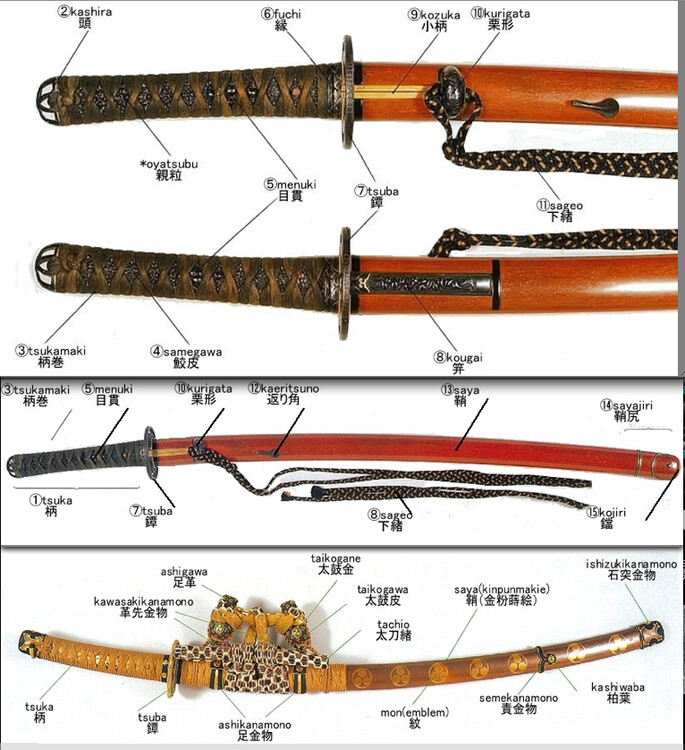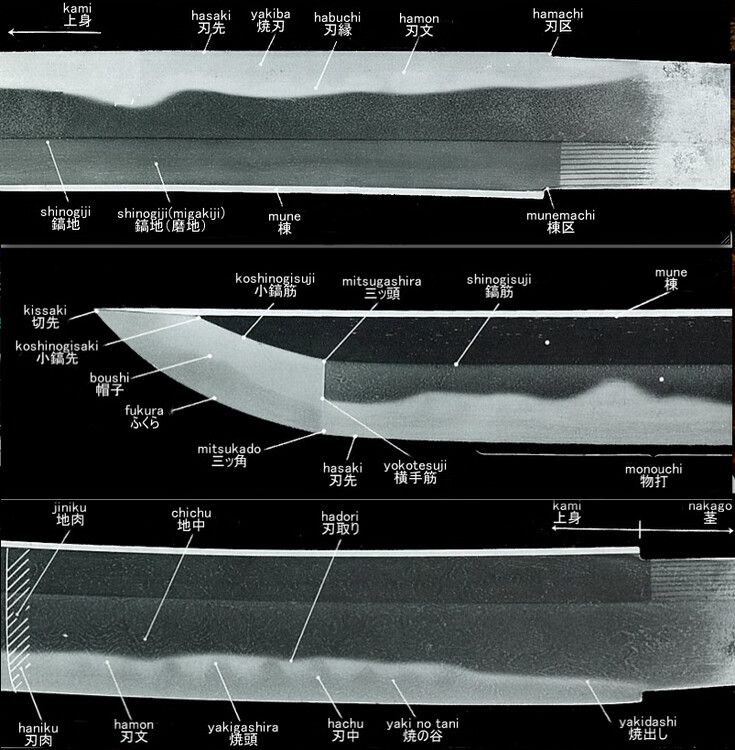-
Posts
779 -
Joined
-
Days Won
1
Content Type
Profiles
Forums
Events
Store
Downloads
Gallery
Everything posted by reinhard
-

How rare is this Tsuba?
reinhard replied to Akitombo's topic in Auctions and Online Sales or Sellers
It is of no big importance, but the box was not made for this particular tsuba. The boxes might have been exchanged a long time ago, but calling it "suitable" is somewhat strange (to say the least). As for the tsuba itself: It is a tsuba with Kaga-style inlay. That's about all one can say. Many western museums with collections of Japanese swords and fittings are nowadays confronted with the fact, that their masterpieces, acquired during Meiji- until early Showa-time, won't stand closer examination anymore. This is not a judgement on the tsuba in question. reinhard -
Here's another pic of the same tsuba taken by daylight and with less disturbing shadows for those, who try to identify the design. reinhard
-
Hello, You are doing a great job so far and it is a pleasure learning with and from you. As soon as I have some more time, I will provide you with pics of the edge and subtler details. To get on with it, I give you the description of the Hozon paper. It can be translated approximately like this: "eight views" design sukashi tsuba maru-gata (round shape) tetsu tsuchime ji (hammered surface) ji sukashi (positive silhouette) dotte mimi (added rim) ryo hitsu ana (both hitsu ana, one plugged with shakudo) The dotte-mimi is not a later addition. It was made of exactly the same steel as the tsuba itself and it has the same deep black color and moist lustre. Focussing on hitsu ana is a very good idea when considering early Akasaka work. The steel quality however is similar to Owari tsuba. My next question is: what does "eight views" mean? reinhard
-
John, The tsuba is almost perfectly round, measuring 8.0cm in diameter, horizontally and vertically. Thickness of the rim is 6 mm, thickness of the seppa-dai is: 4 mm. There are faint tekkotsu and multi-layer forging is visible. But before presenting the solution on a silver tablet: What about the design? What does it show and in what way are those topics related? And what about numbers? reinhard
-
My dear forumites, I would like to show you a tsuba for open discussion. Although it is attributed by NBTHK to ?, it is a mumei tsuba and I would like to know what YOU are seeing in it. Age, design, craftsmanship and so forth. Being more familiar with blades myself, I just wonder what you think. Don't be shy. This is supposed to be a learning experience for all of us. reinhard
-

Togishi: Contrary opinions on using uchiko
reinhard replied to Marius's topic in General Nihonto Related Discussion
There are basically two different views about sword-polishing nowadays. The Hon'ami-based approach is strictly conservative, saying: All that matters is the blade, not the owner. This way of polishing was invented to preserve the blade as long as possible. As a side-effect, subtle details of a blade will be visible only after years or even decades of GENTLE sword-care. - Some people however don't want to wait until then. There are ways to bring out all features immediately, even to the untrained eye, including the use of chemicals lately, but at the expense of a sword's lifetime. This means: Some swords are meant (according to polish and state of preservation) to be GENTLY treated with uchiko once in a while and others are not. reinhard -
Thank you Moriyama-San and Markus for your explanations. The reasons why I was looking for another possible translation are the many origami by Hon'ami family, ending with KAN when relating to value (always as a suffix). I was wondering if measurement/currency could be related to "tetsu" in some way. Now I know they can't. Thanks. John, the TOSHIRO/FUJISHIRO translation is solely based on Hawley's compilation. Not my favourite one, but up to now the only source providing any reasonable info concerning this mei. Though it is not fully reliable and I don't feel very comfortable about it, nobody else came up with a better idea yet. reinhard
-
Hi Moriyama-San and Markus, A simple question about "kantetsu" from someone not perfectly familiar with Nihon-Go: On-reading "KAN" just meaning 8 1/2 pounds, combined with (on-reading) "TETSU" meaning steel, sounds more like a unit of measure than a name to me. The same characters can be read (kun-reading): tsuranu(ku) (i.e. pierce, perforate) and kurogane (i.e.iron). Supposed that on- and kun-reading should not be mixed within one expression: which one of the two translations is the more likely: measurement or "war-name"? reinhard
-
Maybe Guido can tell us something about Chinese sense of humour. A good laugh it was anyway. reinhard
-

sorry but in my previous listing the pictures dissappeared
reinhard replied to gumanthon's topic in Translation Assistance
This particular mei is somewhat tricky indeed. Hawley mentions it one time as FUJISHIRO and and a second time as TOSHIRO (written with the same characters). In both cases, he is said to have signed MASANAGA earlier in his career. Obviously this is the same person and FUJISHIRO/TOSHIRO, although a common name as well, is supposed to be taken for his artist-name. This is in accordance with your sword. The nakago seems to be unshortened. The mei is complete and not part of a longer one cut off since. Unfortunately it seems to be very difficult to find any reference material for comparison. This is neither good nor bad. Maybe someone else comes up with more material on this subject. reinhard -

sorry but in my previous listing the pictures dissappeared
reinhard replied to gumanthon's topic in Translation Assistance
This is kind of strange. Your previous thread about the same issue is still posted and all you have to do is re-uploading your pictures there. As I said: The mei probably reads: Mutsu Aizu TO-SHI-RO If the mei turns out to be genuine, the sword was made during early ShinTo-period in Iwashiro province. reinhard -

token ichi
reinhard replied to shrinkjag81's topic in Sword Shows, Events, Community News and Legislation Issues
If I got this right, the "iai-face" is oscillating between being constipated (Ford) and heavenly relaxation afterwards (Guido). Thank you, gentlemen. reinhard -

Tokubetsu Juyo Chogi @ Christies, spring 2007
reinhard replied to Darcy's topic in General Nihonto Related Discussion
So do I. And I don't want to know what some of these swords look like some years from now. It is bothering me for some years now, to see old and precious heirlooms in the hands of complete ignorants, who don't know how to spend or invest their money anymore. Let's hope they'll disappear untouched in a safe until the oil and gas-barons have all dripped dry. reinhard -

Sword Display
reinhard replied to Chishiki's topic in Sword Shows, Events, Community News and Legislation Issues
Congratulations for doing a great job. reinhard -

token ichi
reinhard replied to shrinkjag81's topic in Sword Shows, Events, Community News and Legislation Issues
I've always wondered what "iai-faces" look like. Are there any pictures? reinhard -
Where did the pics go? reinhard
-
Despite of its qualities, this is a typical example of a Hama-mono, made for export during later 19th century. reinhard
-
This mei might read: Mutsu Aizu TO-SHI-RO (early ShinTo-period in Iwashiro) reinhard
-

Request with Hira-zukuri Ko-wakazashi please
reinhard replied to D-Lewis's topic in Translation Assistance
Jean, The blade you are showing was originally made as a naginata. Most of the nakago was cut off and the point-section reshaped. As you probably know, naginata exist in various lengths since very early times. Therefore it is no contradiction to the afore-said statements. reinhard -

Request with Hira-zukuri Ko-wakazashi please
reinhard replied to D-Lewis's topic in Translation Assistance
Hi Doug, The idea of wakizashi existed only rudimentary before early Muromachi (Oei) period and certainly not before Nanbokucho period. During Nanbokucho period tanto became exaggerated in measures, slightly exceeding one Shaku (30.3cm) in length at the beginning. Technically they must be named (ko-)wakizashi nowadays, but they were actually made in the shape of very big tanto in hira-tsukuri shape. During middle and late Nanbokucho period, when extremely huge o-dachi were made, the size was sometimes extended again and these (few) blades can't be called oversized tanto anymore. There is a hira-tsukuri wakizashi (juyo token) by Yoshii KAGENORI, unshortened, signed and dated Joji third year (1364) with a nagasa of 49.2cm. The difference to your blade is the sugata. The KAGENORI blade is still made in a shape reminding of tanto, whereas your wakizashi clearly shows the idea of wakizashi. I'm afraid I can't explain this in short terms. J&J de France are both right: Condition of nakago and mei suggest a date of manufacture not before later Muromachi period and true wakizashi dating from Kamakura period just don't exist. To your question about sori: It is quite tricky to tell from amateur pics, but the sori of your blade seems definitely to be saki-sori. The center of curvature seems to be at least in the middle of the blade and the curvature towards the point is very strong. This is more obvious on the lower pic. reinhard -

Request with Hira-zukuri Ko-wakazashi please
reinhard replied to D-Lewis's topic in Translation Assistance
Hi Doug, What I can tell from your pictures and infos: A hira-tsukuri wakizashi of 44cm+ with a mei > hardly shortened or ubu > not older than later Nambokucho period Obvious saki-sori > not older than later Muromachi period (Tenmon to Tensho period) Hamon seems to be a mixture of notare and gunome midare with togari > Soshu and Mino roots The mei "SUKEMUNE" (associated with Suruga Shimada-school) fits in quite well there and the mei looks quite similar to some reference material I found, but there is one irritating thing: The Kanji for "SUKE" is missing the very first stroke to begin with and I can't find any genuine example parallel to this. Eventually someone else can. reinhard -
It's no secret: The images are an assembly of reduced and rearranged screenshots from the Ginza Choshuya site. This particular page is online for the public for some years now. My idea was basically to create a stable point of reference somewhere on this forum without posting a link, that will become more and more difficult to find in the future, to a page, that will eventually disappear some day. This doesn't have to be necessarily the collage from Choshuya. It just seemed to be a good starter. Moriyama-san is correct, of course, when pointing to the copyright here. On the other side: If copyrights for every single picture taken from books or web-pages are to be taken 100% seriously, half of all posts on this forum needed to be deleted. Sorry for stepping on toes here. reinhard
-
It might be useful to have a reference point for checking terminology within this forum. Feel free to correct/ add to this first suggestion. reinhard
-
Thank you Morita-san, For those unfamiliar with Kanji, the mei reads: Kato (family name) JUMYO (artist name) reinhard
-

WW2 blade brought back from Papua New Guinea
reinhard replied to Rich Thomas's topic in Translation Assistance
The third year of Meiji era was a kanoe-uma year, but not knowing how to write the name of your emperor properly is more than suspicious. reinhard










